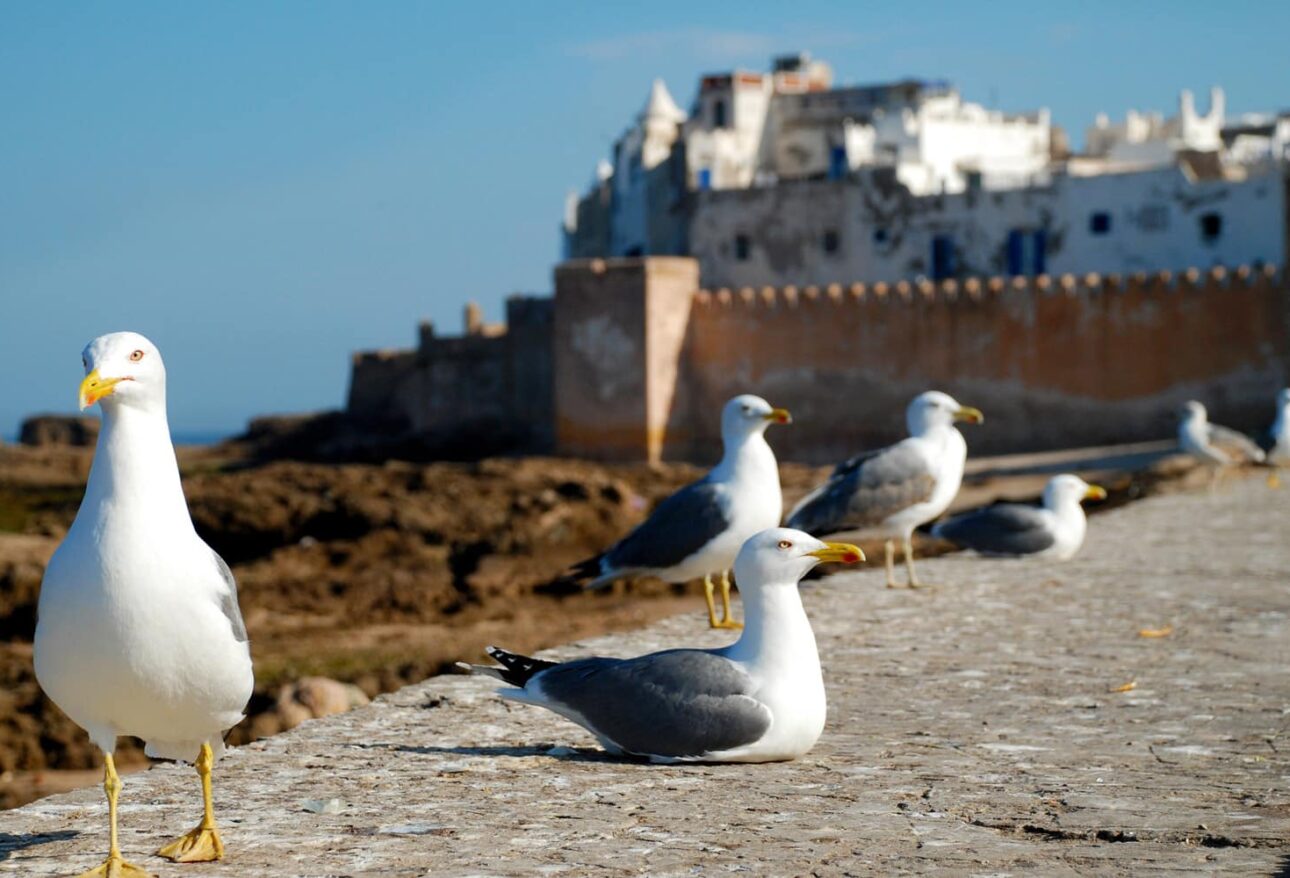The coastal breeze – the beautifully named Alizee, or taros in Berber – has enabled Essaouira (الصويرة, pronounced essa-weera by locals) to hold on to its distinctive culture and character. The region gets such a strong wind during summer that lying on the beach is impossible, so many beach lovers skip visiting the area in favor of other summer Atlantic Coast destinations.
The Picturesque Essaouira
Visiting Essaouira’S Ramparts
Essaouira’s ramparts stand where the medina meets the Atlantic Ocean. Built in the early 1760s, French military architect Theodore Cornut constructed these city walls to protect the city from pirate raids. Based on the town of Saint-Malo in France, the design was developed. You may recognize the ramparts from the 1952 Orson Welles film Othello if you’re a vintage film fan. A shot of a caged Iago hanging over the rocks, which was shot here, was the movie’s opening scene.
A monumental Skala, which is a sort of defensive bastion, lines the seafront ramparts. Skala du Port, a gateway to the fishing port, is located near one end of the docks. At the other end of Skala du Ville is the Skala of the City, marked by 19 bronze cannons along the sea wall. On the ramparts, you can get a great view of the medina and the ocean and find many artisans and craftsmen setting up shop along the waterfront’s perimeter or in the arches underneath, which were initially military stores.
The Perspective of the Boats
The 19th century saw Essaouira as Morocco’s most important port. A caravan carrying goods like gold and spices from sub-Saharan Africa would reach here and be shipped out to Europe and the Americas. Thus, it became known as the Port of Timbuktu. Since the water is not deep enough for large modern ships, port cargo is a bit smaller today. Nevertheless, there’s still plenty of activity going on in Essaouira, and watching the sailors at work is among the most popular activities.
The traditional blue wooden boats continue to be used today, and fishermen are often seen mending their nets, and shipbuilders work on these crates. In the afternoon, around 3 pm and 5 pm, fishing boats arrive at the dock, and fishermen auction off their catch for the day. As the negotiation goes back and forth, you can observe it. Or you can pick up some freshly caught seafood or fish which can be grilled at stalls or markets along the seaport’s edge – the otters and other wild animals will be enthusiastic about getting their paws on any leftovers.
Wandering in the Medina
UNESCO has listed Essaouira’s medina, formerly known as Mogador, as a World Heritage Site because of its atypical mix of Moroccan and European styles. Although Essaouira’s medina might resemble a maze, you’re less likely to get lost entirely here than in many other Moroccan towns and cities.
Throughout the streets, you’ll explore narrow alleyways lined by tall whitewashed buildings. As you go along, you’re sure to encounter twists and turns, yet it’s laid out on a French grid, so it’s generally easier to stay on course. Place Moulay Hassan is the center of the media. This is a beautiful pedestrianized square where you grab a seat in one of the cafés and watch people doing their routine.
Blood Red Sunsets
Its proximity to the coast gives Essaouira the prestige of being the perfect place for watching the sun dip slowly below the horizon. Looking out at the Atlantic from the city, one might experience a magnificent sunset light show. On a clear day, the sun fading makes the sandstone glow gold, bringing the fishing boats and seagulls into sharp relief. Taros Bar in Place Moulay Hassan has a rooftop terrace that provides exceptional views of the sunset. Grab a spot along the ramparts, or head up to the rooftop for a prime sunset viewpoint.
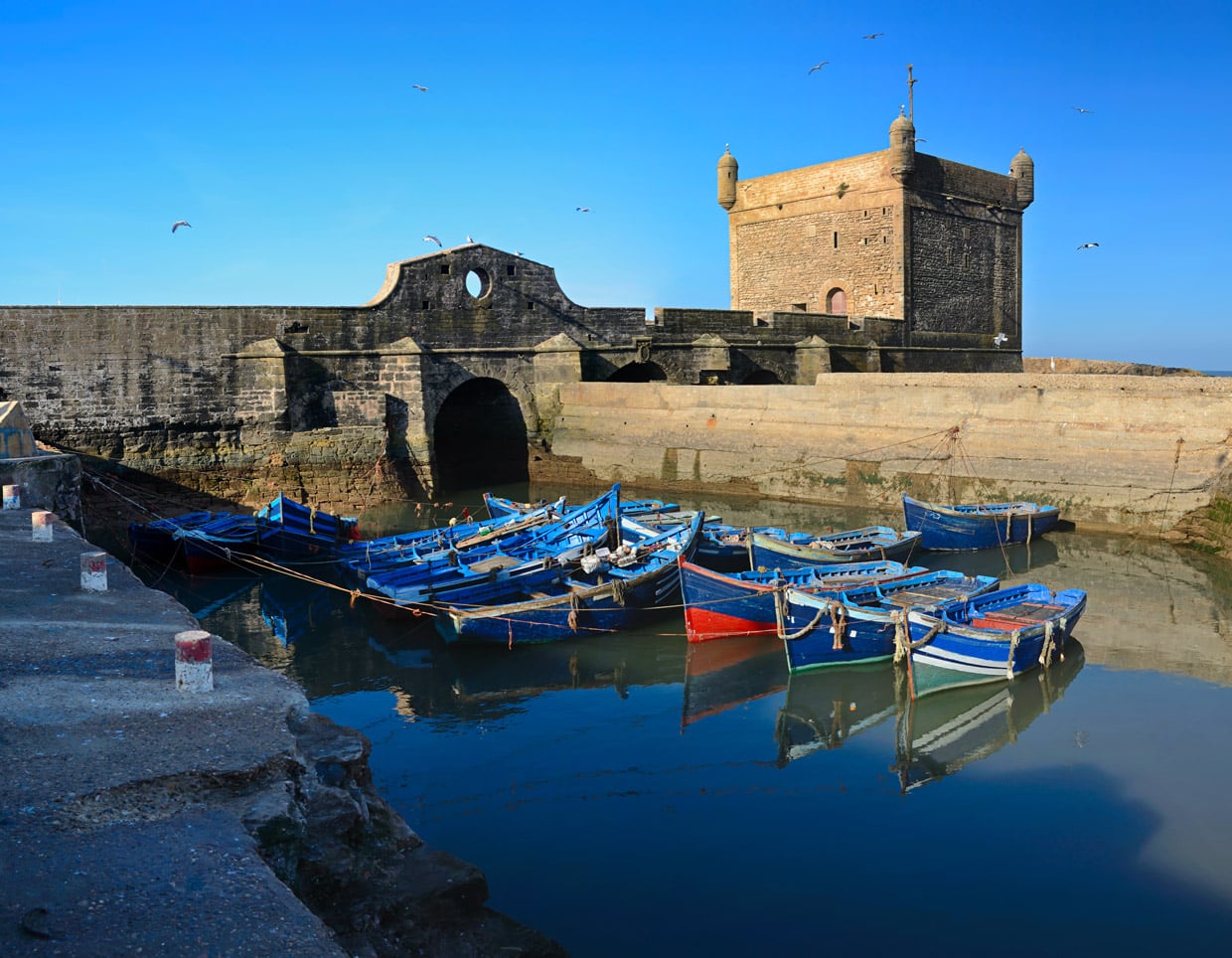
Essaouira for Adventurers
Having Some Adrenaline
Some people speak of Essaouira as the windy city, which is partly justified but not necessarily bad. While the rest of Morocco is likely to become hot and sticky in the heat, the trade winds blowing into the gulf keep temperatures down in the mid-20s °C during summer. And if a slight sandblast doesn’t bother you, you can still enjoy the beach.
But many beachgoers prefer a more active beach experience rather than just lying in the sun. It’s an ideal place for windsurfing or kitesurfing due to the mild, calm water, and even if you don’t get to try it yourself, it’s a sight to watch. A few other activities include going horseback riding along the coast, riding camels through the dunes, or renting bikes and cycling along the beachfront promenade.
Swaying with the Rhythm of Music
Although widespread throughout the entire country, Gnawa music is centered in Essaouira. The music of this type was originally from Senegal, Sudan, and Ghana, and slaves carried it over to Morocco. The music and wild dancing create a hypnotic trance in which spirituality, rhythm, and eroticism collide. The instrumentation is limited to three – the krakets (iron castanets), Sintir (a three-string bass), and the voice.
This music can be enjoyed at the Gnaoua World Music Festival in June or the Gnawa Blues restaurant. In addition to Gnawa, you’ll find Festival des Alizés in April for classical music and the Festival des Andalousies Atlantique in November, a showcase for Arabic and Andalusian music.
Washing Dust Away in a Traditional Hammam
You may find yourself craving recalibration after exploring the marvelous and mysterious Essaouira. Moroccan people have preserved an ancient tradition of taking a hammam (public spa) bath for generations. It is a ritual that is as essential to their lives as eating tagine and drinking mint tea, thus demonstrating your deep understanding of the history and culture. Islam brought a spiritual aspect to the Hammams that had their roots in the Roman era. Besides the lack of hot water in private households, the value of a purified body for praying helped hammams thrive.
Bathers can refresh themselves with the rhythm of bathing with a touch of change from their old ways, starting with a dry, heated zone for relaxation and pores to open, followed by entering a steam room. Bathers apply Savon Beldi, an olive-oil soap known for its intense body scrub, by a Kessa loofah. After that, you get rinsed and scrubbed until the surface of your body is free of dirt, bacteria, and stress.
Being communal, hammams may be confusing or uncomfortable for those who are not accustomed to them. You should not worry, though. Take a cue from the attendant and let the process unfold. Before going to a Hammam, inquire about what to bring. A variety of supplies will likely be required, including a pair of plastic sandals, a shower scrub, and a sense of humor and curiosity. A participatory ritual like this can reveal various aspects of culture and a glow on your skin you wouldn’t have imagined beforehand.
Gastronomy in Essaouira
Preparing a Morrocan Dish
A great way to take a taste of the place you spent your vacation is to learn some local foods. Half-day cooking classes are offered at L’Atelier Madada with a local chef in both French and English. After learning how to make Moroccan mint tea, cook a two-course meal, and the day ends with a tour of the spice souks.
Whoever books in for that day first gets to pick what you cook, and you can choose from a variety of traditional tagines, as well as other dishes like Pastilla (a pastry made with layers of puff dough), Zaalouk (an aubergine salad), or Briouates (triangular stuffed pies).
Having a Prepared Morrocan Dish
Going out to eat is an excellent alternative for the lazy on a night like this. You can purchase freshly caught fish and seafood at the fish souq and the nearby port, along with fresh orange juice. Restaurants in Essaouira provide healthy food like smoothies and salads, Italian seafood dishes, classy Moroccan food, tapas, and tasty organic vegetarian and vegan food. They also offer unique and various atmospheres for having meals.
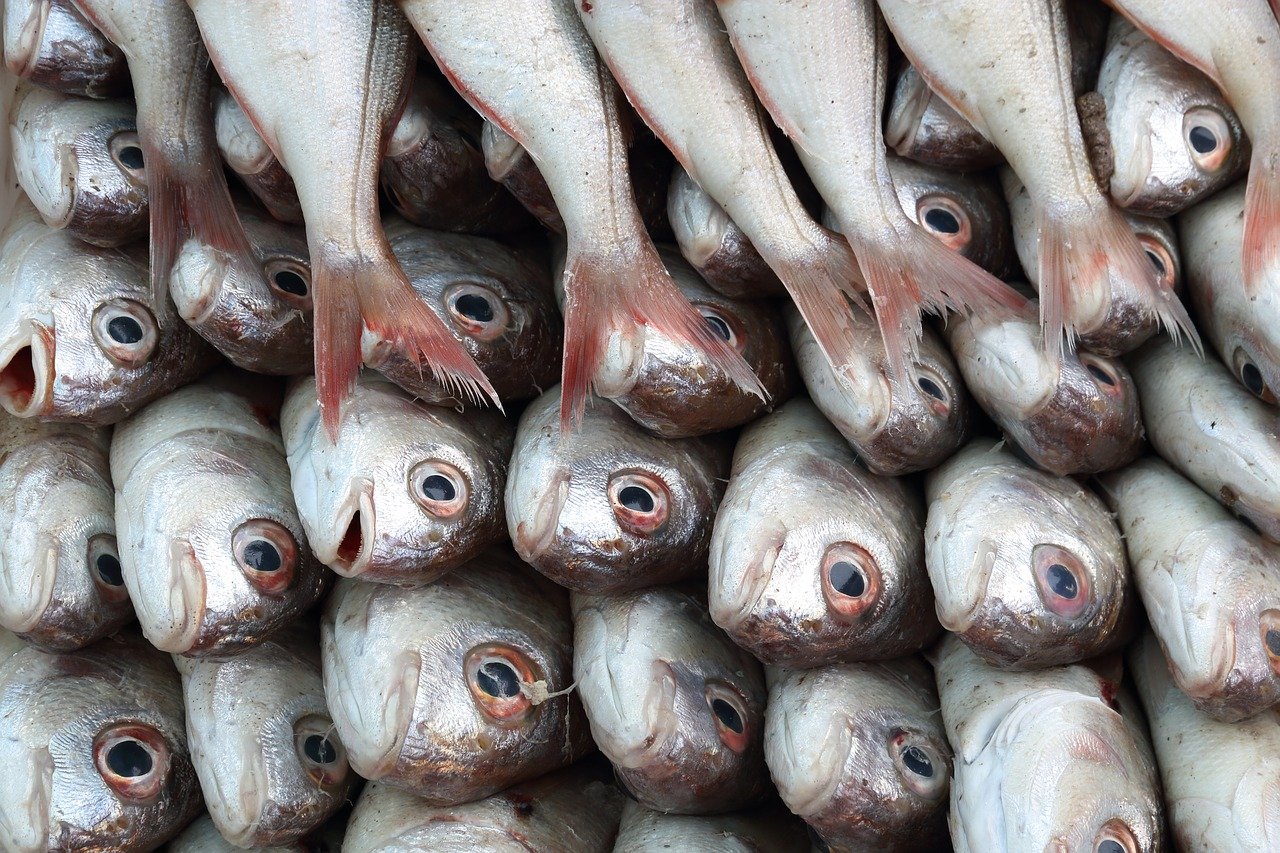
Souks of Essaouira
Before you experience the chaos of the more significant markets in Marrakech or Casablanca, practice your bargaining skills in Essaouira’s laid-back souks. There are also many produce stalls selling fresh meat, fish, and aromatic spices (the custom Ras el Hanout mix makes a good present for someone back home), as well as souks that sell jewelry and make-to-measure clothes.
A flea market in La Joutia square is another place where treasures can be found. Elsewhere in the medina, you can purchase gifts like regional artworks, argan oil from the cooperatives, silver ornaments made by Jewish silversmiths, elegant marquetry boxes, and furnishings sculpted from thuya wood, and the mystical lotions and herbs produced by the Berber pharmacists.
When to Visit
Essaouira is truly a holiday paradise all year round. April through October offers the best climate, although winter can also be nice. Those who enjoy swimming or beach holidays are most welcome to use the coastal city between July and October. The temperatures in winter, from November to March, are of a much milder scale than in Central Europe, but you should still expect rain. The sea breeze never stops in Essaouira, hence its nickname, the “City of the Wind.”
If you are not from this part of the world, so you can not tell the temperature of this city while you are on your journey. It is believed that the table of average temperature or the amount of precipitation is an important factor for those who want to spend some time there. Here you can see the details about the weather in Essaouria.
[wpsm_colortable color=”main-color”]
| Month | Min (°C) | Max (°C) | Mean (°C) | Min (°F) | Max (°F) | Mean (°F) |
|---|---|---|---|---|---|---|
| January | 10 (°C) | 18 (°C) | 14 (°C) | 50 (°F) | 64 (°F) | 57.2 (°F) |
| February | 11 (°C) | 18 (°C) | 14.5 (°C) | 52 (°F) | 64 (°F) | 58.1 (°F) |
| March | 12 (°C) | 19 (°C) | 15.5 (°C) | 54 (°F) | 66 (°F) | 59.9 (°F) |
| April | 13 (°C) | 19 (°C) | 16 (°C) | 55 (°F) | 66 (°F) | 60.8 (°F) |
| May | 14 (°C) | 20 (°C) | 17 (°C) | 57 (°F) | 68 (°F) | 62.6 (°F) |
| June | 16 (°C) | 21 (°C) | 18.5 (°C) | 61 (°F) | 70 (°F) | 65.3 (°F) |
| July | 17 (°C) | 23 (°C) | 20 (°C) | 63 (°F) | 73 (°F) | 68 (°F) |
| August | 18 (°C) | 23 (°C) | 20.5 (°C) | 64 (°F) | 73 (°F) | 68.9 (°F) |
| September | 17 (°C) | 23 (°C) | 20 (°C) | 63 (°F) | 73 (°F) | 68 (°F) |
| October | 16 (°C) | 22 (°C) | 19 (°C) | 61 (°F) | 72 (°F) | 66.2 (°F) |
| November | 14 (°C) | 21 (°C) | 17.5 (°C) | 57 (°F) | 70 (°F) | 63.5 (°F) |
| December | 11(°C) | 19 (°C) | 15 (°C) | 52 (°F) | 66 (°F) | 59 (°F) |
| Year | 14.1 (°C) | 20.5 (°C) | 17.25 (°C) | 57.4 (°F) | 68.9 (°F) | 63 (°F) |
[/wpsm_colortable]
Not only the average temperature but also the precipitation and the shining hours are the things you must know before heading there. Let’s have a look at them:
[wpsm_colortable color=”main-color”]
| Month | Millimeters | Inches | Days |
|---|---|---|---|
| January | 45 | 1.8 | 7 |
| February | 40 | 1.6 | 7 |
| March | 35 | 1.4 | 7 |
| April | 30 | 1.2 | 6 |
| May | 10 | 0.4 | 3 |
| June | 2 | 0.1 | 1 |
| July | 0 | 0 | 0 |
| August | 1 | 0 | 1 |
| September | 5 | 0.2 | 2 |
| October | 25 | 1 | 5 |
| November | 50 | 2 | 7 |
| December | 55 | 2.2 | 7 |
| Year | 300 | 11.7 | 53 |
[/wpsm_colortable]
And the table of shining hours in Essaouira:
[wpsm_colortable color=”main-color”]
| Month | Average | Total |
|---|---|---|
| January | 6.5 | 210 |
| February | 7.5 | 205 |
| March | 8 | 245 |
| April | 9 | 265 |
| May | 9.5 | 290 |
| June | 9.5 | 290 |
| July | 9.5 | 300 |
| August | 9.5 | 290 |
| September | 8.5 | 250 |
| October | 7.5 | 235 |
| November | 6.5 | 195 |
| December | 6.5 | 200 |
| Year | 8.2 | 2980 |
[/wpsm_colortable]
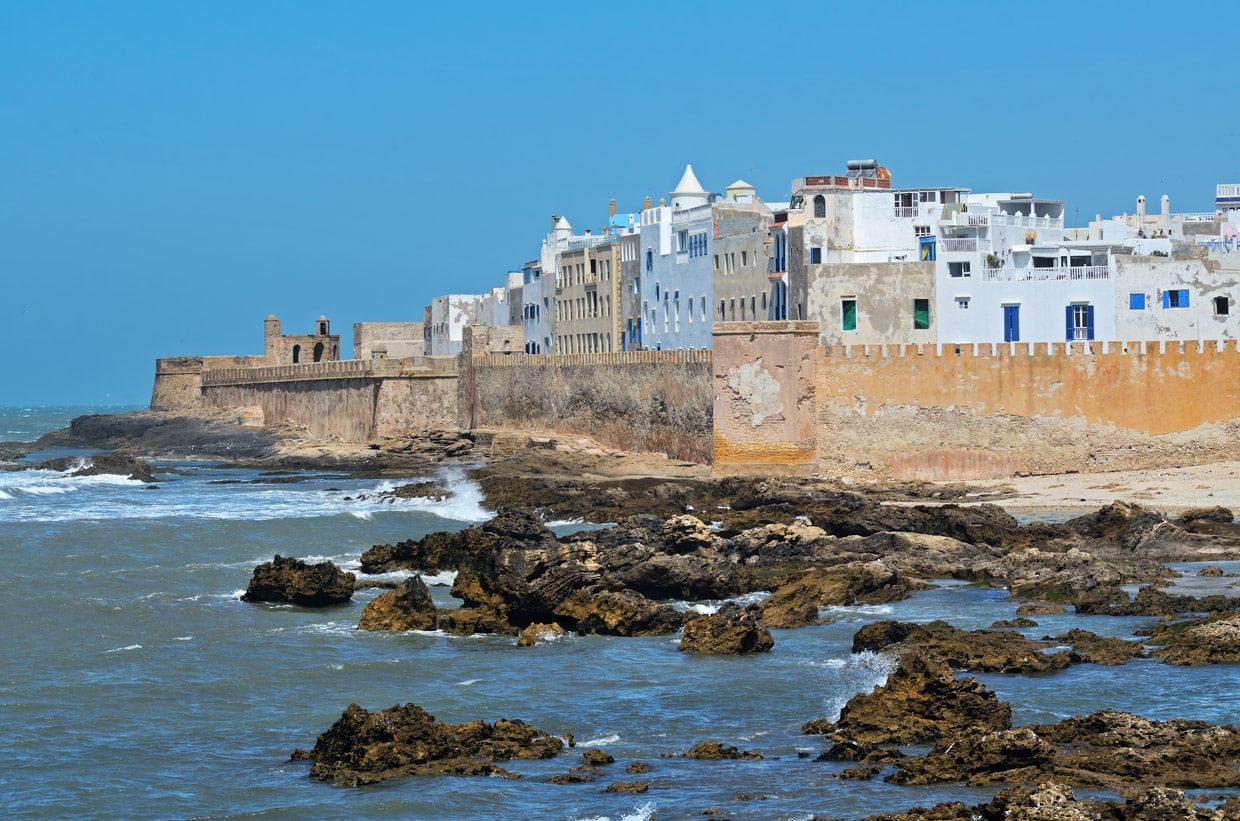
Where To Stay
With a large variety of accommodations, Essaouria has something for everyone. The most authentic and classy Moroccan experience awaits you in a traditional Ryad. A warm spa is also available at luxurious Ryads to help you relax. A majority of the Ryads and hotels are of budget price ranges to luxury standards. A number of hostels are also available for those who prefer a more casual living environment. They serve lovely traditional Moroccan breakfasts in a pleasant communal atmosphere.
Getting There
You can land at Essaouira Airport (ESU) in the immediate vicinity. Unfortunately, there is hardly an international flight to be found. Because of this, travelers would be best advised to book flights to Marrakech (2.5 hours from Essaouira) or Agadir (3 hours from Essaouira). Taxis, buses, and rental cars are all options to get to Essaouira from that point. Buses can fill up quickly in peak periods, so try to book your tickets the day before. The coastal city of Morocco should always be included in your itinerary for those who rent a car.
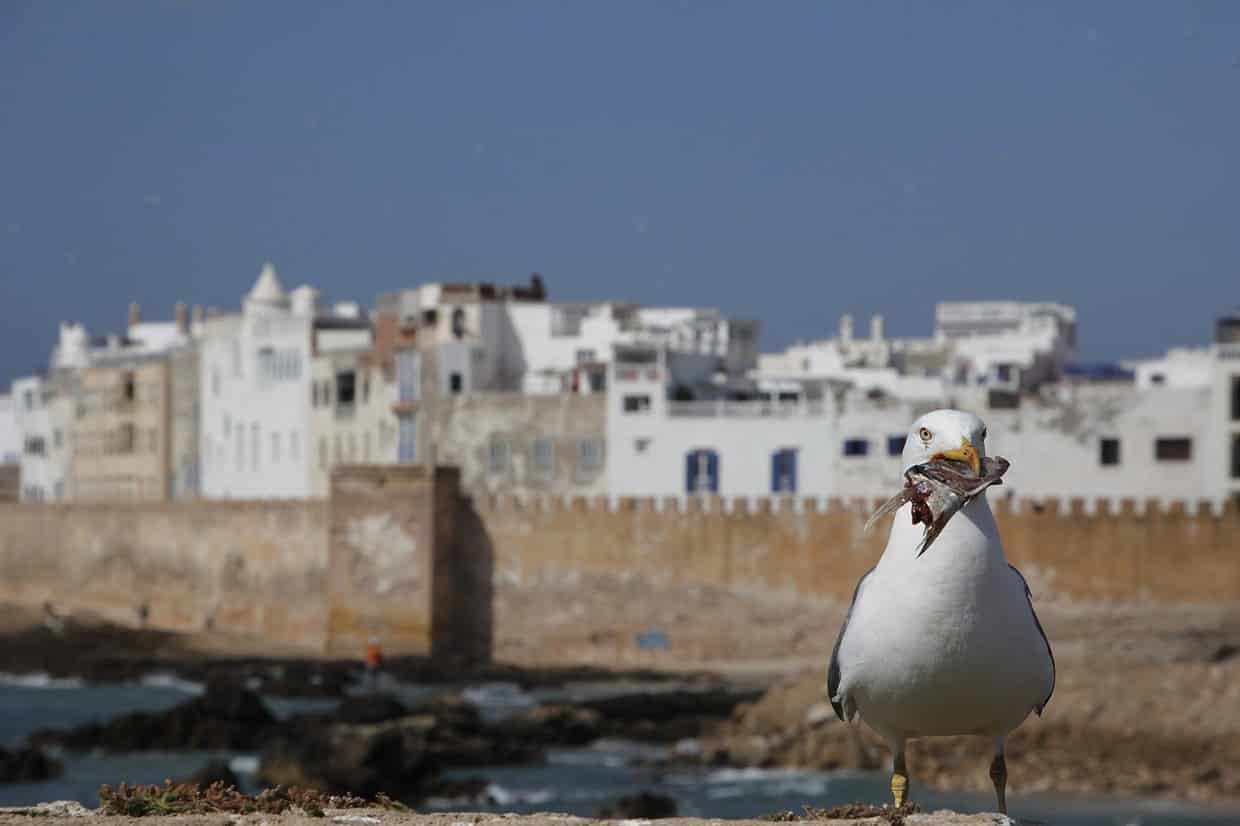
Where to Go Next
Marrakech
It is interesting to note how Marrakech, a famous red city, contrasts with Essaouira, a white & blue city. So we recommend you to plan for visiting Marrakech after Essaouira. Here are also many amusing spots for you to explore. Marrakech provides mysterious historical attractions, as well as natural ones.
Sidi Kaoki
Morocco, with its southwestern coastline, is home to numerous famed surfing spots. The Sidi Kaoki beach is located south of Essaouira and has become famed as one of the most popular surf meccas in Morocco. Sidi Kaoki also has a great atmosphere for non-surfers so that you can enjoy an excursion as well!

